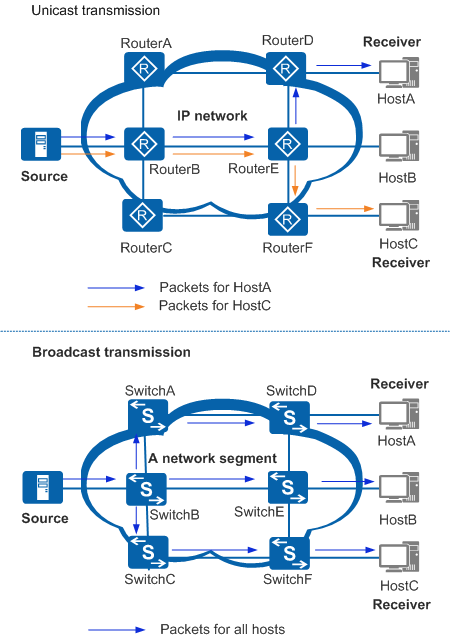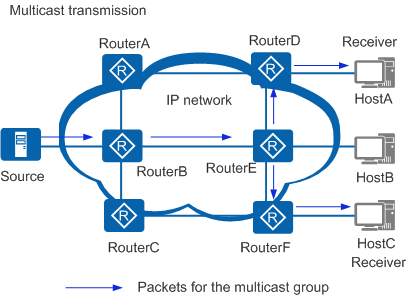Overview of IP Multicast
Definition
In IP multicast transmission, packets are transmitted from a source to a group of receivers. Unlike unicast and broadcast transmission, IP multicast transmission saves network bandwidth and reduces loads on a network by allowing network nodes to replicate information as needed, preventing broadcast congestion from causing problems such as erratic display and mosaic. IP multicast is widely used in IPTV, real-time data transmission, and multimedia conferencing services.
Purpose
Traditional IP communication supports two transmission modes: unicast and broadcast.
- In unicast transmission, a source sends an independent data packet to each host that has requested the data.
- In broadcast transmission, a source sends data to all the hosts on the local network segment, regardless of whether the hosts have requested the data.
To transmit data to multiple, but not all, destination hosts, a source host broadcasts the data to all receivers or sends multiple copies of data to the destination hosts one by one, as shown in Figure 1.
- In unicast mode, the amount of data transmitted on the network is proportional to the number of users who have requested the data. If a large number of users require the same data, the source host must send many copies of the data to these users, consuming high bandwidth on the source host and network. Therefore, unicast is not suitable for batch data transmission and is applicable only to networks with a small number of users.
- In broadcast mode, data is sent to all hosts on a network segment regardless of whether they have requested the data. This threatens information security and may cause broadcast storms on the network segment. Therefore, broadcast is not suitable for data transmission from a source to specific destinations. It also wastes network bandwidth.
In summary, traditional unicast and broadcast modes cannot effectively implement point-to-multipoint data transmission.
Multicast is a solution to point-to-multipoint data transmission. As shown in Figure 2, the source sends only one copy of data, and all the hosts that have requested the data (HostA and HostC) can receive the same copy of the data. HostB will not receive the data.
- Compared with unicast, multicast starts to copy data and distribute data copies on a network node as far away from the source as possible. Therefore, the amount of data and network resource consumption will not increase significantly when the number of receivers increases.
- Compared with broadcast, multicast transmits data only to the receivers that have requested the data. This conserves network resources and enhances data transmission security.
Multicast can be used in any point-to-multipoint data transmission scenarios, including:
- Multimedia and streaming media applications
- Remote training and collaboration
- Data warehouse and financial applications (stocks and securities)
Internet service providers (ISP) use IP multicast technology to provide Internet services, such as online live broadcasting, web TV, online education, telemedicine, web radio, and video/audio conferencing.

